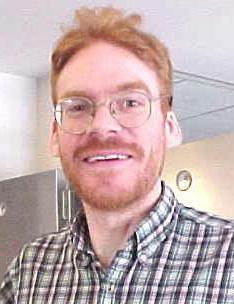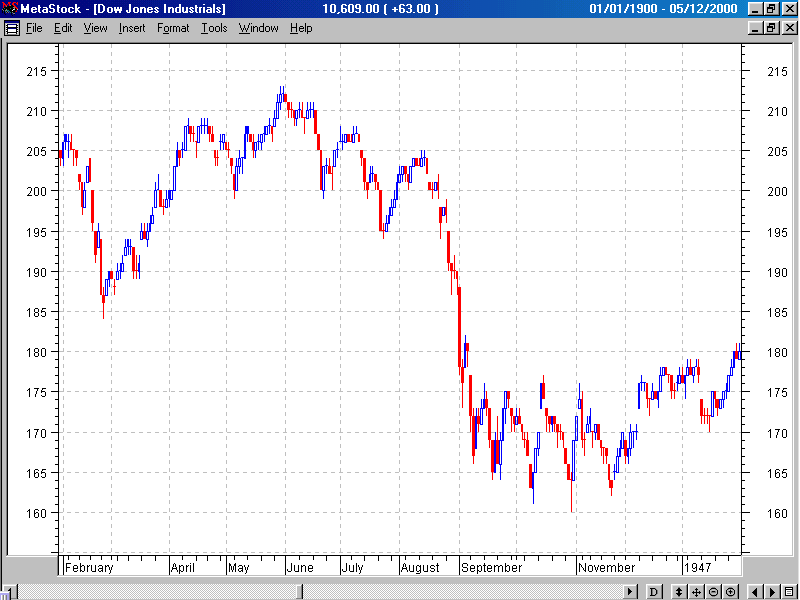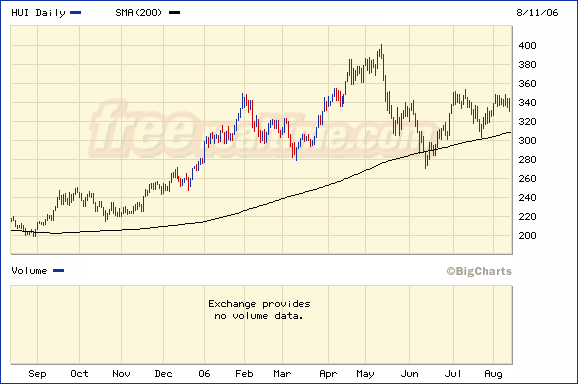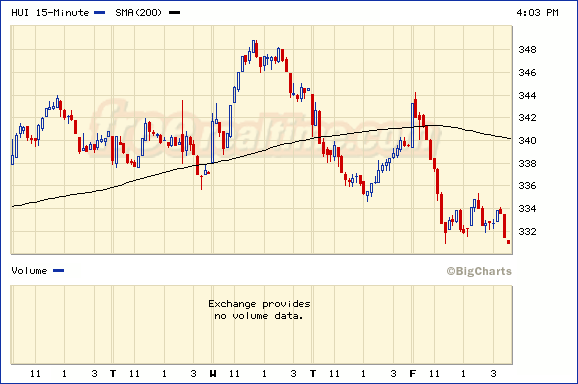|
A true contrarian look at investing and at life in general.
|
Back Issue List
|
|
Updated
@ 1:00 a.m. EDT, Monday, August 14, 2006.
|
|
DAILY SUBSCRIPTION SERVICE AVAILABLE: I am currently offering an e-mail subscription service for $104.50 (U.S. dollars) for one year, or $35 for three months. This service will provide daily e-mails giving specific timely buy/sell recommendations, as well as long-term guidelines for money management. As an example of this service, I sent an e-mail in the morning of Monday, May 22, 2006, recommending that subscribers switch from being short precious metals shares to being short the precious metals funds GLD and SLV. Since then, HUI has risen 8%, while GLD has dropped 3% and SLV has declined 9%. Payment can be made through PayPal, credit card, or check, whichever you prefer. Your e-mail address will not be given to any other person or organization under any circumstances. The price of this subscription will increase the next time that HUI goes below 270, since that is when I will be giving my primary buying recommendations for precious metals shares.
Please Take Me to the Subscription Page
History may not repeat itself, but it does rhyme a lot. --Mark Twain
Jewelry Auction-Live Bullion Quotes ==> 
A special thanks to Mr. Don McEachern for designing the
beautiful banner at the top of the web site, and a slightly different one seen on the back issue list.
A sincere note of appreciation to my internet host, DirectNIC, located in downtown New Orleans, for remaining in their offices continuously throughout the disaster, keeping their web sites up and running during almost the entire time of the hurricane and flood. That is service above and beyond the call of duty.
WELCOME TO TRUE CONTRARIAN! I will attempt to create an entertaining, readable, and hopefully refreshing viewpoint roughly once per week. Each issue will feature my intermediate-term financial outlook, my long-term financial outlook, and a personal reminiscence from my journal.
Your comments are always welcome, or send an e-mail to sjkaplan@earthlink.net.

Recent comments are in boldface. Using an excellent suggestion of Mr. Dmitry Bouzolin, I am labeling each paragraph with the date on which it was written, beginning with my last update.
EQUITIES WORLDWIDE, INCLUDING GOLD MINING SHARES AND THE SHARES OF OTHER COMMODITY PRODUCERS, ARE SET TO LOSE 25% OF THEIR VALUE IN JUST THREE MONTHS OR LESS (August 14, 2006): One of the most reliable cycles in the financial markets is the four-year equity cycle, often called the "Presidential cycle". Every four years since World War II, without exception, U.S. equities have made an important bottom, usually in the autumn. Some of these lows have been especially notable as major bear-market nadirs, including 1974, 1982, 1990, and 2002.
To me, the most amazing thing is that, even with this pattern as reliable as the four seasons, investors continue to ignore it. It is as though, every July, people convinced themselves that since it is so hot, we are unlikely to have snow the following winter.
It is now August 2006, so we are right on schedule for another deep low this autumn. Between now and late October or early November, we are likely to have a 25% decline for most major midcap equity indices. Some largecap indices will fall by slightly less, while many smallcap indices will decline by a greater percentage, as largecaps move back into phase for a period of several years, and smallcaps move out of phase.
Have you looked at a chart of the Dow Jones Industrial Average lately? Check this out:
The above chart shows typical bearish behavior, in which amateurs are eagerly buying each morning, while informed institutions and insiders are selling heavily into all rally attemps. In addition to making lower highs, there is a pattern of lower lows, also known as a bearish engulfing pattern.
A 61.8% Fibonacci retracement of the entire gain in HUI from its nadir of 165.71 on May 16, 2005, to its peak of 401.69 on May 11, 2006, would put HUI at 255.85. Interestingly, the initial resistance level for HUI, from December 2, 2003, which was not exceeded for about two years, was 258.60. Notice that both of these numbers are nearly identical. Since a Fibonacci retracement level is usually broken by a few percent to the downside, while former resistance--now support--is often also broken by a similar percentage, both of these methods yield a final HUI low of 248. This bottom will probably be nearly simultaneous with the 2006 autumn nadir in the Nasdaq.
QQQQ, an exchange-traded fund of the top 100 companies in the Nasdaq by market capitalization, has been making a bearish pattern of lower highs since January 11. The sharpest part of the decline is about to begin. If you're doing a lot of short selling, lean back, open up a cold beer, and enjoy. Otherwise, I would recommend getting up off your rear end and rearranging your portfolio to position yourself in a proper defensive mode. Those who don't kick butt are about to have their butts thoroughly kicked.
(August 14, 2006) HUI, the Amex Index of Unhedged Gold Mining Shares, has fully and convincingly completed a very bearish head-and-shoulders top with 2 left shoulders and 3 right shoulders, as follows:
First left shoulder: 349.48, January 31, 2006.
Second left shoulder: 354.59, April 6, 2006.
Head: 401.69, May 11, 2006.
First right shoulder: 342.68, June 5, 2006.
Second right shoulder: 353.50, July 12, 2006.
Third right shoulder: 348.84, August 9, 2006.
HUI is also completing a long-term bullish interlocking head-and-shoulders bottom with 3 left shoulders and 1 right shoulder, as follows:
First left shoulder: 278.47, March 10, 2006.
Second left shoulder: 270.54, June 13, 2006.
Third left shoulder: ???.??, September ??, 2006 (274.5 estimated).
Head: 2??.??, October ??, 2006 (248 estimated).
Only right shoulder: 2??.??, November ??, 2006 (282.5 estimated).
HUI CORRECTIONS IN THE PAST 4 YEARS (February 5, 2006): HUI, the Amex Goldbugs Index of Unhedged Gold Mining Shares, has experienced four corrections averaging more than 1/3 in magnitude in the past four years. Here are the precise dates and figures of each such pullback:
2002: 154.99 on June 4, 2002 to 92.82 on July 26, 2002: 40.1%.
2003: 154.92 on January 6, 2003 to 112.61 on March 13, 2003: 27.3%.
2003-2004: 258.60 on December 2, 2003 to 163.81 on May 10, 2004: 36.7%.
2004-2005: 248.18 on November 17, 2004 to 165.71 on May 16, 2005: 33.2%.
2006: 401.69 on May 11, 2006 to ???.?? on ??? ??, ????: ??.?% [I'm guessing the eventual low will be near 248, a decline of 38%].
CONSIDER FUNDS FIRST: Most readers will probably be interested in purchasing gold funds for the majority of their investment, either not having a brokerage account or not wishing to assume the increased risk and volatility of owning shares of individual companies. There are several dozen gold funds. (May 29, 2006) As of May 22, 2006, there is a new exchange-traded fund of gold mining shares called GDX, which is intended to track the Amex-listed index GDM. More information on GDX can be found at http://www.vaneck.com/gdx. The management fee for GDX is currently only 0.55%, which may be increased to 0.79% in another year. Since GDX has the lowest fee of all true gold funds, and can be traded intraday, it is currently my favorite gold fund. ASA is a closed-end fund of precious metals shares, heavily weighted in South Africa. Since the management fee is currently 1.15%, I do not heavily favor it, but it does trade intraday, and so may be worth buying in small quantities whenever its discount to net asset value exceeds 15%, which happens occasionally. All but three of the open-end gold funds charge more than 1.2% percent of the total assets each year as a management fee, in some cases two or three percent annually. Some of these funds even charge significant upfront or redemption fees. If you feel that a particular fund manager has a track record which justifies such a high expense ratio, then please continue to invest in such a fund. However, it is possible that such a manager may not continue his winning streak, or that his success may encourage him to leave for another company or to start his own hedge fund, and the subsequent management will not necessarily be as competent, and may charge a significant fee for switching out of the fund. Caveat emptor. The two open-end funds which charge the most reasonable fees are BGEIX, the American Century Global Gold Fund (current annual expense ratio 0.67%), and VGPMX, the Vanguard Precious Metals and Mining Fund (current ratio 0.48%). I have a strong preference for BGEIX over VGPMX, for the following reasons: 1) BGEIX charges a redemption fee of 1% only if the shares are held for less than 60 calendar days. VGPMX charges a 1% fee if the shares are held for less than a year. 2) BGEIX contains all pure gold mining companies. VGPMX contains several energy and base metal producers. If there is a fear of a recession, or similar economic developments, energy and base metal producers will likely underperform ordinary gold mining shares. Besides, I do not want diversification if I am purchasing a gold fund; I want gold mining shares, period. 3) BGEIX has always been open for new investment. VGPMX sometimes is closed for new investment, even if one has a considerable current holding in the fund. Appendix (May 30, 2005): One of my readers, Mr. Alan Sorin, pointed out that FSAGX, the Fidelity Select Gold Fund, has an expense ratio of 0.89% and a short-term trading fee of 0.75% for shares held less than 30 days. While this is not as low a fee as BGEIX, there is one big advantage: FSAGX is priced every hour on the hour, beginning at 10 a.m. New York time, rather than only at 4 p.m. As readers who have been tracking gold mining shares for many years already know, being able to buy and sell at 10 a.m. is worth a lot, since it is around this time of day that gold mining shares usually make their lows when they are forming an important bottom. Sometimes HUI will rise several percent between 10 a.m. and 4 p.m., as it did on May 10, 2004 (when HUI made its nadir of 163.81). Once it is appropriate to sell gold mining shares, it is also usually advantageous to do so at 10 a.m., when they generally peak during the formation of market tops.
CURRENT ASSET ALLOCATION (August 14, 2006, marked to market): My own personal funds are currently allocated as follows: LONG POSITIONS: stable value fund (retirement fund with stable principal paying variable interest, currently 5.25%), 15%; long-dated U.S. Treasuries and their funds, and long-dated municipal government bonds, including TLT and MYJ, 30%; Treasuries between 2 and 10 years in duration, such as IEF, 9%; TOC, 2%; gold and silver coins and related metals collectibles, 6%; other collectibles, 0.5%; cash and cash equivalents including a long position in VMSXX, negative 27.5%; SHORT POSITIONS: Nasdaq-equivalent (QQQQ, SMH, NDX, GOOG) and related shorts, 42%; short CFC, 3%; short GLD, 20%.
GOLD AND REALITY: Gold and gold mining shares often correlate closely to the real rate of return for short-term U.S. time deposits. The lower the real rate of return, the better for gold and its shares, and vice versa. The real rate of return is equal to the nominal time deposit rate (roughly equal to the anticipated Federal funds rate) minus the inflation rate. (July 27, 2006) At the current time, inflation is about 3.15% while the anticipated Federal funds rate is approximately 5.40%, yielding a real rate of return of positive 2.25%, its highest positive level in more than five years. Since gold and silver strongly prefer a negative real interest rate to a positive one, this is bearish for precious metals. Investors in gold appear to have entirely forgotten its important negative correlation with the real rate of return, making it that much more important at this time. It should be noted that when gold experienced its lowest point in 1999-2001, the inflation rate averaged 2.0% while the anticipated Federal funds rate was as high as 6.5%, yielding a real rate of return of as much as positive 4.5%. This positive 4.5% rate of return is the primary reason why gold fell all the way to $252 per troy ounce, not because of some ridiculous manipulation theory.
LOOKING FORWARD TO 2060: I'll make a very far forward prediction by stating that I believe U.S. equities will make a double bottom in 2010 and 2018, with the Nasdaq bottoming in 2010, more than doubling sometime thereafter, and then making a final double-bottom retreat in 2018, followed by a roaring bull market that will (August 4, 2006) create a very long-term double top for the Nasdaq just above 5000 by perhaps 2037, followed by the next secular bear market. The all-time Nasdaq high of 5132.50 from March 2000 will probably not be seen again until around 2060, six decades after it had previously visited that mark, and obviously representing a much lower real level because of inflation. (February 5, 2006) Jeremy Grantham, in the February 6, 2006 edition of Barron's, makes the exact same timewise prediction: U.S. equities will achieve their deepest nadir in 2010. His logic is that any asset class typically takes about one decade to go from top to bottom (U.S. equities peaked in March 2000). U.S. residential real estate lovers, take heed: the peak in August 2005 [National Association of Realtors] implies that the bottom for U.S. housing prices will occur near 2015.
LONG-TERM GOLD OUTLOOK: Gold will continue to make a pattern of higher lows as its strong bull market from a nadir of $254.00 in April 2001 to the present continues throughout the next decade or so. Important higher lows included $319.10 on April 7, 2003; $371.25 in the morning of Monday, May 10, 2004; $410.75 on February 8, 2005; and $428.00 on August 30, 2005.
YOUR TYPICAL GARDEN-VARIETY SEVERE BEAR MARKET BOTTOM: U.S. equities in general will continue to decline until the dividend yield on the S&P 500, currently at 1.95%, is between 6.5% and 10.5%. Great bull excesses are usually followed by equally severe recessions.
REMINISCENCE OF THE WEEK (August 4, 2006): At the age of fifteen, when I was studying music one chilly Saturday winter morning at the Peabody Preparatory of Music in Baltimore, a sharply dressed nine-year-old boy approached me and asked if I could please turn pages for him. Assisting other students was a common courtesy, so I told him that I would happily do so, and could he please lead me to his classroom. The boy's father appeared, and told me that the request was not for a lesson, but for a recital later that afternoon. The father then invited me to have lunch at an elegant restaurant in the neighborhood with himself, his wife, and the kid. I happily accepted, surprised that I would receive such royal treatment just for turning a few pages at some obscure "Prep" recital that perhaps a dozen people would attend. After our meal, we proceeded to the back of the main Conservatory concert hall, which made me wonder why we were taking such a circuitous route to the building where I had always given my own student piano recitals. Suddenly I found that we were ascending the backstage area at one of Baltimore's premier concert halls, with several dozen professional musicians around me tuning up their instruments. I was puzzled, so I blurted out, "What's going on?" The boy's father replied, "My son, who recently won the U.S. under-ten piano competition, is about to perform Beethoven's Fourth Piano Concerto. It is the final rehearsal and the media should be in attendance. Please follow him onto the stage and sit to his left, where we have placed an extra seat for you." The boy's parents left the stage. A moment later, the curtain rose, and as I walked to my seat, I heard a sudden loud applause. I turned toward the source of the noise, and gasped as I faced the largest audience I had ever seen anywhere, complete with TV cameras zooming in and out. The boy remained quite relaxed throughout, but I don't think I have ever been as nervous as I was during that performance. Fortunately, my page turning was sufficiently competent that it did not interfere with his playing. The father was gracious enough to give me free tickets to the final concert the following week, which the young prodigy performed without sheet music, and which received very favorable nationwide publicity.
Please Take Me to the Best of Previous Reminiscences
(c) 1996-2006 Steven Jon Kaplan Your comments are always welcome.
AUTOBIOGRAPHICAL SKETCH: I was born and raised in Baltimore, Maryland, U.S.A., and was graduated from the Johns Hopkins University with a Bachelor of Engineering Science degree in May 1982. I have been studying the precious metals markets since the 1970s, and began this web site in August 1996. I have been writing music and short stories since the mid-1960s. I maintain a fiercely independent stand toward the financial markets and toward everything else in life, and am not compensated for my writings by any person or organization with the exception of the advertising banners posted on this site. I am also a pianist, computer programmer, music composer, bridge player, and runner, and enjoy world travel. I appreciate all those who have quoted the various sayings on my web site over the years, which have wound up in some pretty interesting collections.
LINKS TO OTHER PAGES:


FastCounter by bcentral






